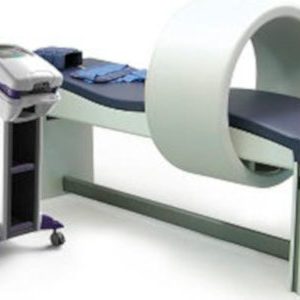The MS-14 is a low intensity PEMF (Pulsed Electromagnetic Field) equipment.
This technology, which has been in existence since the 1950s, is beneficial for a wide range of pathologies and has scientific support from the medical literature that supports its use.
PEMF treatments were first used by Soviet Union astronauts in space missions and later NASA researched and patented their use as a way to prevent bone loss, muscle atrophy and fatigue, especially for astronauts during and after space travel.
This type of medical equipment is used to treat many conditions such as depression, fractures, post-operative edema, pain and superficial soft tissue regeneration.
Its use is also widely known by athletes who seek to improve their athletic performance due to the effect of increasing cellular uptake of oxygen after treatment.

The effectiveness of PEMF in treating various pathologies has been proven in numerous medical studies around the world.
- The healing time for bone fractures is substantially reduced
- Stimulates cartilage growth, increasing collagen production.
- Increases muscle relaxation.
- Increases healing potential in chronic wounds and ulcers.
- Osteoporosis and Osteoarthritis
- pain reduction
- Increased growth of osteoblasts and osteoclasts (bone cells)
- Positively impact bone remodeling and microfracture healing.
- Improves sports performance
- Allows for faster recovery time.
- Stimulates muscle energy production and oxygen uptake
How does it work?
A strong magnetic field is obtained when an electrical current flows through the wires inside the rim (solenoid) in the device. Since the current is varied (and the wave and field shape modulated), the MS-14 generates a pulsed magnetic field.
The variation in frequency and intensity allows different biological effects on cells through the depolarization of cell membranes by electromagnetic waves. Namely, it stimulates the piezoelectric effect necessary for bone growth and self-regulation
How long does it take?
We recommend between 10 to 15 sessions to get the best results.
Who benefits from it?
People who suffer with or from:
- Osteoporosis
- Osteoarthritis
- Rheumatoid Arthritis
- Bone Fractures
- Degenerative Arthropathy
- Spondylitis
- Fibromyalgia
- Head Injuries
- Migraines and Headaches
- Neuralgia
- Burns
- Ulcers
- Soft Tissue Injuries
- Disc Herniation
- Tendonitis
- Carpal Tunnel Syndrome
- Postoperative Pain
- Multiple Sclerosis
- Cartilage Damage
- Depression
Also effective for:
- Faster Postoperative Healing
- Improved Sports Performance
Can be performed in:
- People with titanium surgical plates and screws
- People with plaster casts
Scientific studies regarding PEMF benefits
- Elshiwi AM, Hamada HA, Mosaad D, Ragab IMA, Koura GM, Alrawaili SM. Effect of pulsed electromagnetic field on nonspecific low back pain patients: a randomized controlled trial. Braz J Phys Ther. 2019
- Reilingh ML1, van Bergen CJ2, et al. Effects of Pulsed Electromagnetic Fields on Return to Sports After Arthroscopic Debridement and Microfracture of Osteochondral Talar Defects: A Randomized, Double-Blind, Placebo-Controlled, Multicenter Trial. Am J Sports Med. 2016 May
- Byers JM1, Clark KF, Thompson GC. Effect of pulsed electromagnetic stimulation on facial nerve regeneration. Arch Otolaryngol Head Neck Surg. 1998
- Fu YC1, Lin CC2, et al. A novel single pulsed electromagnetic field stimulates osteogenesis of bone marrow mesenchymal stem cells and bone repair. PLoS One. 2014 Mar 14;
- Yuan J1, Xin F2, Jiang W1. Underlying Signaling Pathways and Therapeutic Applications of Pulsed Electromagnetic Fields in Bone Repair. Cell Physiol Biochem. 2018
- Gossling HR1, Bernstein RA, Abbott J. Treatment of ununited tibial fractures: a comparison of surgery and pulsed electromagnetic fields (PEMF). Orthopedics. 1992 Jun
- Kubat NJ1, Moffett J2, Fray LM2. Effect of pulsed electromagnetic field treatment on programmed resolution of inflammation pathway markers in human cells in culture. J Inflamm Res. 2015 Feb
